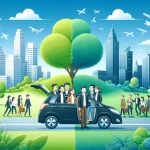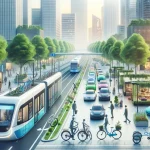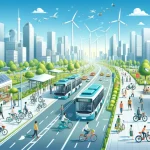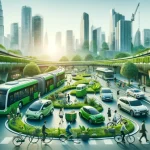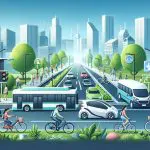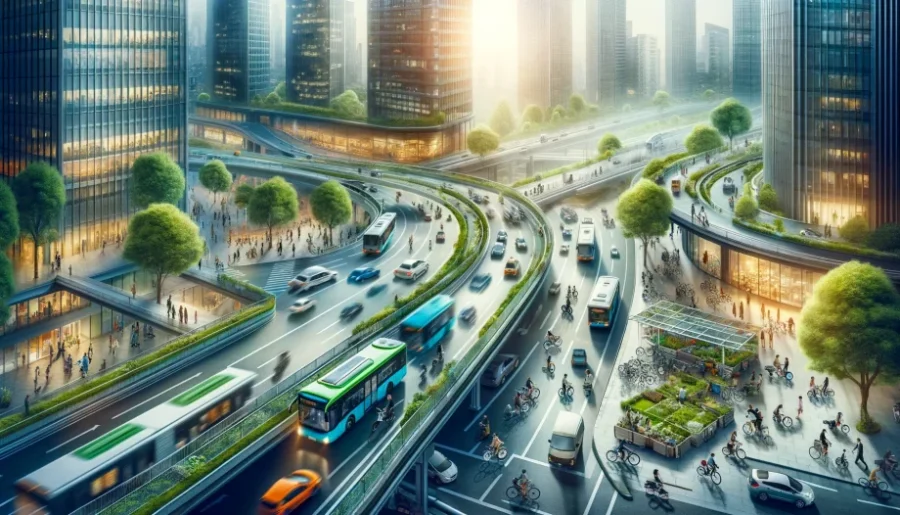
Explore how the role of transportation in urban development shapes cities, boosts economic growth, and enhances quality of life. Dive into our insights now!
Role of Transportation in Urban Development Key Takeaways:
- The role of transportation in urban development is critical for shaping city landscapes, enabling economic growth, and improving quality of life.
- Efficient transport systems facilitate access to jobs, education, and healthcare, and reduce traffic congestion.
- They contribute to sustainable urban environments by supporting mixed-use development and reducing carbon emissions.
Transportation is a vital backbone of urban development, seamlessly connecting different parts of the city and facilitating the smooth movement of people and goods.
This blog post delves into the multifaceted impact of transportation systems on cities, exploring how they contribute to the dynamism and sustainability of urban areas.
Role of Transportation in Urban Development
Transportation systems are the lifelines of cities, serving as the foundation upon which urban development is built.
They do more than just move people from point A to point B; they connect communities, drive economic vitality, and lay the groundwork for sustainable urban environments.
The role of transportation in urban development is multifaceted, influencing everything from the daily routines of individuals to the global economic network.
Connecting Communities
Firstly, transportation networks bridge distances, making it possible for people to access jobs, education, and healthcare.
This accessibility is crucial for the social and economic inclusion of all urban residents, fostering a sense of community and belonging.
Efficient transportation systems enable cities to thrive by facilitating the flow of goods and services, which is essential for business operations and economic growth.
They attract investments and create job opportunities, thus acting as catalysts for urban prosperity.
Driving Economic Growth
Moreover, the design and implementation of transportation infrastructure directly impact the physical layout of cities.
They determine urban form, land use patterns, and the density of development, which in turn affect the quality of life for city dwellers.
Thoughtfully planned transportation systems can help minimize traffic congestion, reduce travel times, and improve air quality by encouraging the use of public transit and non-motorized modes of travel like walking and biking.
Enhancing Urban Sustainability
Sustainability is another crucial aspect of transportation’s role in urban development.
As cities continue to grow, the challenge of balancing development with environmental preservation becomes increasingly important.
Sustainable transportation systems are key to reducing greenhouse gas emissions, combating climate change, and ensuring that urban areas remain livable for future generations.
Initiatives like expanding public transit options, promoting electric vehicles, and developing pedestrian-friendly spaces are examples of how transportation can contribute to more sustainable and resilient urban areas.
In a Nutshell:
In summary, transportation is a cornerstone of urban development, essential for connecting communities, supporting economic growth, and advancing sustainability. As cities evolve, the continuous innovation and improvement of transportation systems will be vital for creating more inclusive, prosperous, and sustainable urban environments.
Historical Context of Transportation in Urban Development
The evolution of transportation has been a driving force behind the transformation and growth of cities throughout history.
From the early days of horse-drawn carriages to the modern era of automobiles and rapid transit systems, the development of transportation methods has deeply influenced both the physical and social landscapes of urban areas.
This journey through transportation history not only reflects technological progress but also the changing needs and aspirations of urban societies.
The Inception of Transportation and Its Initial Impact on Urban Areas
In the beginning, cities were largely shaped by the limitations of human and animal power.
The introduction of horse-drawn carriages and boats along waterways enabled the expansion of cities beyond their original cores.
This era of transportation allowed for greater mobility of people and goods, leading to the initial growth and specialization of urban areas.
Markets, industries, and residential areas began to develop in distinct zones, facilitated by the available means of transportation.
Major Milestones in Transportation History and Their Effects on Urban Sprawl
As technology advanced, so did transportation methods. The invention of the steam engine and the subsequent development of railways in the 19th century revolutionized urban development.
Cities could now expand far beyond the constraints of earlier transportation modes, leading to urban sprawl and the development of suburbs.
The automobile’s advent in the early 20th century further accelerated this trend, allowing for even greater personal mobility and reshaping cities into car-centric landscapes.
Case Studies: Transformation of Major Cities like New York and Los Angeles with Transportation Advancements
- New York City: The development of the NYC subway system in the early 20th century had a profound impact on New York City, enabling the dense urbanization of Manhattan and the outer boroughs.
- The subway facilitated the growth of the central business district and residential neighborhoods, making New York a model of public transit’s role in urban development.
- Los Angeles: In contrast, Los Angeles exemplifies the influence of the automobile on urban form. The city’s extensive freeway system developed mid-20th century, encouraged low-density suburban growth and became a symbol of the car’s impact on city planning and lifestyle.
In a Nutshell:
These case studies illustrate the significant role that transportation advancements play in shaping urban environments.
As cities continue to evolve, the historical context of transportation provides valuable lessons on the interplay between technology, urban planning, and societal needs.
Understanding this history is crucial for addressing the challenges and opportunities of future urban development, as transportation remains a key factor in determining the quality of life and sustainability of urban areas.
Transportation’s Impact on Economic Growth
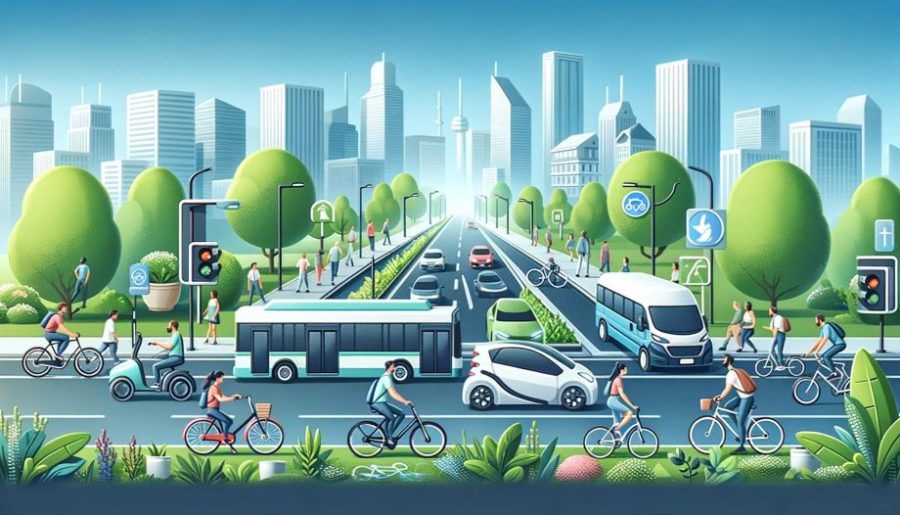
Transportation systems play a pivotal role in the economic development of urban areas.
They serve as the arteries through which the lifeblood of the economy—goods, services, and people—flows.
Efficient transportation not only facilitates this flow but also attracts businesses, boosts job creation, and opens up myriad economic opportunities.
Understanding the relationship between transportation infrastructure and economic growth reveals how integral these systems are to thriving urban environments.
Link Between Transportation Infrastructure and Economic Opportunities
- Access to Markets: Transportation systems expand access to local, national, and international markets, enabling businesses to reach a wider customer base.
- Attracting Investment: Well-developed transport infrastructure is a key factor for attracting investment in real estate, manufacturing, and services.
- Enhancing Productivity: By reducing travel time and costs, efficient transportation increases productivity and competitiveness.
The Vital Role of Transport in Connecting Markets and Fostering Trade
- Facilitating Trade: Transportation is essential for both importing raw materials and exporting finished products, driving trade and economic growth.
- Economic Integration: Improved transport networks facilitate economic integration, allowing regions to specialize and benefit from economies of scale.
- Supporting Services: The expansion of transportation also supports the growth of service industries such as logistics, finance, and tourism.
Examples of Cities That Have Experienced Economic Revitalization Through Transportation Investments
- Dallas, Texas: The development of the DART (Dallas Area Rapid Transit) system has significantly contributed to the city’s economic growth, attracting businesses and reducing congestion.
- Portland, Oregon: Investment in light rail and streetcar systems has revitalized downtown areas, spurred economic development, and enhanced the city’s livability.
- Singapore: This city-state has become a global hub for trade and finance, in part due to its efficient public transport system and strategic location, demonstrating the economic benefits of investing in transportation.
Table: Economic Benefits of Transportation Infrastructure
| Benefit | Description | Example Cities |
|---|---|---|
| Job Creation | Transportation projects generate employment in construction, maintenance, and transit operations. | Dallas, Portland |
| Market Accessibility | Improved transport systems enhance access to local and global markets, boosting trade. | Singapore, Rotterdam |
| Attracting Investment | Quality transportation infrastructure attracts businesses and investments, stimulating local economies. | Atlanta, Munich |
In a Nutshell:
These examples underscore the transformative power of transportation investments in stimulating economic development and revitalizing urban areas.
By enhancing connectivity, reducing costs, and improving efficiency, transportation systems not only support the current economic fabric of cities but also lay the groundwork for future growth and prosperity.
The Role of Transportation in Shaping Urban Form and Land Use
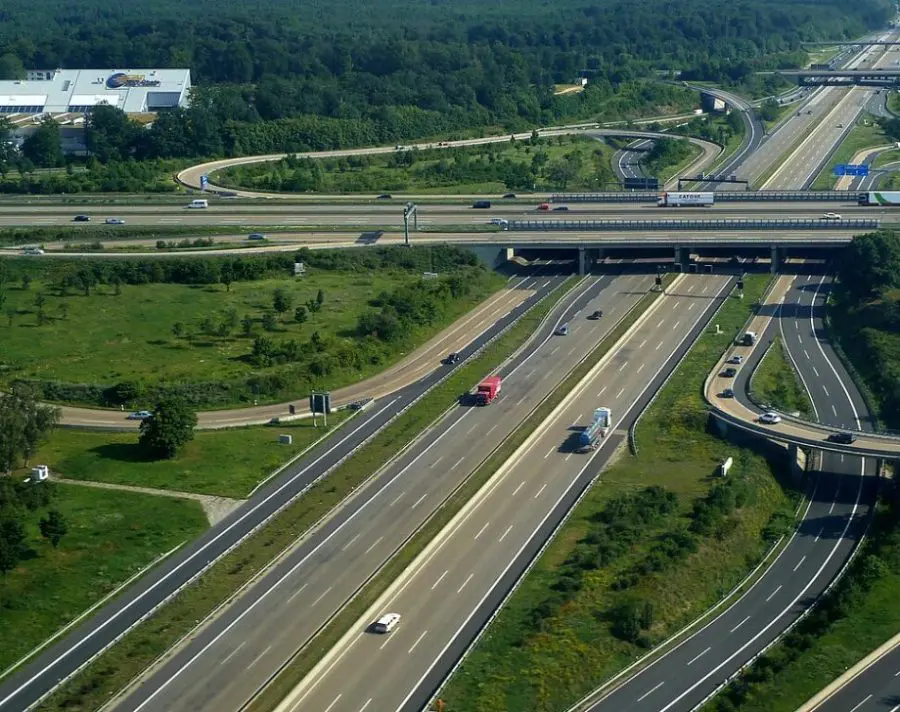
Transportation plays a critical role in shaping the urban landscape, influencing how cities are planned, developed, and experienced by their residents.
The design and implementation of transportation infrastructure directly impact the layout of cities, dictating the distribution and accessibility of residential, commercial, and recreational spaces.
This relationship between transportation and urban form is fundamental to creating livable, efficient, and sustainable urban environments.
Relationship Between Transport Infrastructure and Urban Planning Decisions
- Determining Urban Layout: The placement of roads, rail lines, and public transit routes shapes the physical structure of cities, influencing where people live, work, and play.
- Influencing Land Values: Transportation accessibility can significantly impact land values, with areas near transit stations often experiencing higher property values and development pressure.
- Guiding Growth: Transportation planning is a tool for urban planners to guide growth towards desired areas, helping to prevent sprawl and encourage more efficient land use.
How Transportation Encourages Mixed-Use Development and Affects Urban Density
- Promoting Mixed-Use Areas: Well-designed transport systems support the development of mixed-use areas, where residential, commercial, and leisure activities coexist, reducing the need for long commutes.
- Increasing Urban Density: By facilitating higher densities, transportation infrastructure can make more efficient use of land, support a vibrant urban life, and make public transit systems more viable.
- Enhancing Walkability: The integration of transportation with urban design can enhance walkability, encouraging pedestrian-friendly environments and reducing reliance on private vehicles.
The Concept of Transit-Oriented Development (TOD) and Its Benefits
- Defining TOD: Transit-oriented development focuses on creating compact, walkable communities centered around high-quality public transport systems, integrating living, working, and recreational spaces.
- Benefits of TOD:
- Reduced Traffic Congestion: TOD can lead to reduced car dependency and traffic congestion by promoting the use of public transit.
- Sustainable Urban Growth: By concentrating development near transit hubs, TOD supports more sustainable land use patterns and reduces environmental impact.
- Economic Vibrancy: TOD areas often become vibrant economic and social hubs, attracting businesses and improving the quality of life for residents.
Table: Impact of Transportation on Urban Development
| Transportation Type | Urban Impact | Examples |
|---|---|---|
| Public Transit | Promotes denser, mixed-use development near transit hubs. | New York City, London |
| Highways | Can lead to urban sprawl and low-density suburban growth. | Los Angeles, Houston |
| Bicycle Infrastructure | Encourages sustainable development and healthier, more active communities. | Copenhagen, |
In a Nutshell:
The role of transportation in urban planning and development is undeniable.
By influencing the spatial organization of cities, transportation infrastructure plays a key role in shaping urban form and land use.
Through strategies like transit-oriented development, cities can harness the power of transportation to create more sustainable, livable, and efficient urban spaces.
Transportation and Environmental Sustainability

The intricate relationship between transportation and environmental health is a critical aspect of urban development.
As cities grow, the demand for transportation increases, often leading to adverse environmental impacts such as air pollution and greenhouse gas emissions.
However, sustainable transport solutions offer a pathway to mitigate these effects, presenting an opportunity to enhance urban environments while protecting the planet.
Understanding and addressing the environmental challenges posed by traditional transportation modes is essential for fostering sustainable urban development.
The Environmental Challenges Posed by Traditional Transportation Modes
- Air Pollution: Vehicles powered by fossil fuels emit pollutants that degrade air quality, impacting human health and the environment.
- Greenhouse Gas Emissions: Transportation is a significant source of carbon dioxide and other greenhouse gases that contribute to climate change.
- Noise Pollution: High levels of noise from traffic can affect the well-being of urban residents and disrupt ecosystems.
The Shift Towards Sustainable Transport Options
- Electric Vehicles (EVs): The adoption of electric vehicles reduces reliance on fossil fuels, decreasing air pollutants and greenhouse gas emissions.
- Public Transit Expansion: Investing in efficient public transportation systems encourages people to shift from private car use, reducing traffic congestion and environmental impact.
- Active Transport Infrastructure: Developing bike lanes and pedestrian paths promotes walking and cycling, low-impact modes of transport that contribute to healthier urban environments.
Case Studies of Cities Leading in Sustainable Transportation Efforts
- Copenhagen, Denmark: Known for its bicycle-friendly infrastructure, Copenhagen has more bikes than cars, drastically reducing carbon emissions and promoting a healthy lifestyle among its residents.
- Curitiba, Brazil: This city is renowned for its innovative Bus Rapid Transit (BRT) system, which serves as a model for efficient and affordable public transportation, helping to reduce congestion and pollution.
- Oslo, Norway: Oslo has made significant strides in promoting electric vehicle use, aiming to become carbon neutral by 2030. The city has invested in EV charging infrastructure and has restricted car use in the city center to decrease carbon emissions.
Table: Sustainable Transportation Solutions and Their Benefits
| Solution | Environmental Benefit | Example Cities |
|---|---|---|
| Electric Vehicles | Reduces greenhouse gas emissions and air pollution. | Oslo, Amsterdam |
| Public Transit Expansion | Lowers individual car use, reducing overall emissions. | Tokyo, Curitiba |
| Bike Sharing Programs | Decreases reliance on motorized transport, contributing to lower emissions. | Paris, Hangzhou |
In a Nutshell:
These case studies illustrate the positive impact that sustainable transportation initiatives can have on urban environments.
By adopting and promoting green transportation options, cities can address the environmental challenges of urbanization, improving air quality, reducing greenhouse gas emissions, and enhancing the quality of life for urban residents.
The transition towards sustainable transportation is a crucial step in the journey towards more resilient and environmentally friendly urban spaces.
Challenges and Solutions in Urban Transportation
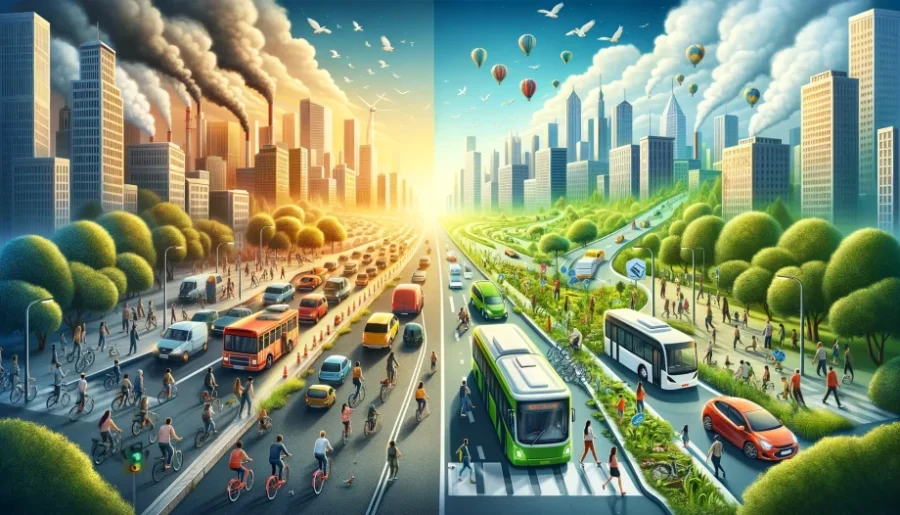
Urban transportation systems face a myriad of challenges as cities continue to grow and evolve.
Traffic congestion, pollution, and the need for sustainable mobility options are just a few of the hurdles that urban areas must navigate.
However, cities worldwide are embracing innovative solutions, leveraging technology and forward-thinking policies to address these issues.
By examining both the challenges and the pioneering strategies being employed to overcome them, we can gain insight into the future of urban transportation.
Key Challenges in Managing Urban Transportation Systems
- Traffic Congestion: As the number of vehicles on the road increases, congestion becomes a significant issue, leading to increased travel times and decreased quality of life.
- Air Pollution: Emissions from transportation contribute to poor air quality, posing health risks to urban populations and harming the environment.
- Sustainability: The transition to sustainable transportation modes is challenging in the face of established car-centric urban layouts and infrastructure.
Innovative Technologies and Policies Improving Urban Transport
- Smart Traffic Management Systems: These systems use data analytics and IoT devices to optimize traffic flow, reducing congestion and improving road safety.
- Integrated Public Transit: Seamless integration of different public transport modes, such as buses, trains, and bike-sharing programs, offers convenient alternatives to driving.
- Policies Promoting Sustainable Mobility: Initiatives like congestion pricing, low-emission zones, and incentives for electric vehicle use are encouraging shifts towards more sustainable transportation habits.
Success Stories of Cities Overcoming Transportation Hurdles
- Singapore: Through its smart traffic management system and strong public transit network, Singapore has effectively managed traffic congestion and maintained high air quality standards.
- Amsterdam, Netherlands: Known for its cycling culture, Amsterdam has successfully integrated bike infrastructure into its urban fabric, reducing reliance on cars and promoting healthy, sustainable mobility.
- Bogotá, Colombia: The city’s investment in the TransMilenio BRT system and the Ciclovía program, which closes city streets to cars on Sundays for cyclists and pedestrians, showcases innovative approaches to urban transportation challenges.

In a Nutshell:
These examples highlight the dynamic ways in which cities are addressing the complex challenges of urban transportation.
Through a combination of technology, policy, and community engagement, urban areas are finding solutions that not only mitigate immediate issues like congestion and pollution but also pave the way for a more sustainable and accessible transportation future.
The journey towards overcoming transportation hurdles is ongoing, but these success stories offer valuable lessons and inspiration for cities worldwide.
Future Trends in Urban Transportation
The future of urban transportation is on the cusp of a significant transformation, driven by advancements in technology and a growing emphasis on sustainability and efficiency.
Emerging technologies such as autonomous vehicles, smart city initiatives, and the integration of digitalization and artificial intelligence (AI) are set to redefine how we move around our cities.
These innovations promise to enhance the efficiency of urban transportation systems, reduce environmental impacts, and improve the overall quality of urban life.
As we look forward, it’s essential to understand the potential of these technologies and how they can shape the future of urban development.
Predictions for Transportation Advancements and Their Urban Impact
- Autonomous Vehicles: The widespread adoption of self-driving cars could revolutionize urban mobility, reducing traffic accidents, optimizing traffic flow, and freeing up space currently used for parking.
- Electric and Hybrid Modes of Transport: The shift towards electric and hybrid vehicles is expected to continue, significantly reducing urban areas’ carbon footprint and improving air quality.
- Mobility as a Service (MaaS): The concept of MaaS, which integrates various forms of transport services into a single accessible platform, is likely to become a mainstream model, offering flexible and efficient transportation options for urban dwellers.
The Role of Digitalization and AI in Shaping Future Transportation Systems
- Smart Traffic Management: AI and machine learning algorithms can analyze traffic data in real time, optimizing signal timings and reducing congestion.
- Predictive Maintenance: Digital tools and AI can predict when transportation infrastructure and vehicles require maintenance, minimizing downtime and improving service reliability.
- Enhanced Safety: AI-driven analytics can improve safety by identifying potential hazards and optimizing routes to avoid accidents.
Preparing Cities for the Next Wave of Transportation Innovations
- Updating Infrastructure: Cities must invest in modernizing infrastructure to accommodate new technologies like autonomous vehicles and high-speed transit systems.
- Policy and Regulatory Frameworks: Developing supportive policy and regulatory frameworks is crucial to ensure the safe and equitable implementation of advanced transportation technologies.
- Public Engagement and Education: Engaging with communities to educate and gather feedback on upcoming transportation innovations is essential for their successful integration into urban life.
In a Nutshell:
The future of urban transportation is bright, with emerging technologies offering unprecedented opportunities to enhance mobility and sustainability.
As cities prepare for this next wave of innovations, the focus must remain on creating inclusive, efficient, and environmentally friendly transportation systems.
By embracing these advancements, urban areas can look forward to a future where transportation not only meets the needs of its residents but also contributes to the broader goals of sustainable urban development.
Role of Transportation in Urban Development FAQs
In this section, we address some of the most common questions concerning the role of transportation in urban development.
By providing clear, insightful answers, we aim to shed light on how transportation systems are integral to the growth and sustainability of urban areas.
Q: Why is transportation important to urban growth?
A: Transportation is crucial for urban growth because it connects people to jobs, education, healthcare, and other essential services.
Efficient transportation systems enable the movement of goods and services, facilitating economic activities and attracting investments.
By improving accessibility and connectivity, transportation plays a vital role in urban expansion and development.
Q: What effect did improved transportation systems have on urban life?
A: Improved transportation systems have significantly enhanced urban life by reducing travel time, increasing accessibility, and improving air quality.
They have made cities more livable by facilitating easier access to work, leisure, and services.
Additionally, these systems have contributed to the economic vitality of urban areas by supporting commerce and enabling the efficient movement of goods.
Q: How does transportation shape urban environments?
A: Transportation shapes urban environments by influencing land use patterns, urban form, and the spatial distribution of activities.
The design and layout of transportation infrastructure, such as roads, rail lines, and transit networks, dictate where residential, commercial, and industrial areas are developed.
Transportation also impacts the density and walkability of cities, playing a crucial role in creating dynamic, sustainable, and livable urban spaces.
Q: What are the effects of transportation-oriented development on a city or neighborhood?
A: Transportation-oriented development (TOD) positively impacts cities and neighborhoods by promoting high-density, mixed-use development near transit stations.
This approach leads to reduced car dependency, lower traffic congestion, and enhanced walkability.
TOD fosters vibrant, accessible communities where people can live, work, and play close to efficient public transportation, contributing to improved quality of life and environmental sustainability.
These questions and answers provide a glimpse into the transformative power of transportation in shaping the future of urban development.
By understanding the critical role that transportation plays, cities can better plan and implement systems that support growth, sustainability, and an enhanced urban experience for all residents.
Transportation in Urban Development Conclusion
Throughout this blog post, we’ve explored the multifaceted role of transportation in urban development, highlighting its impact on economic growth, urban form, environmental sustainability, and the overall quality of urban life.
The journey from horse-drawn carriages to autonomous vehicles and smart city initiatives illustrates transportation’s transformative power in shaping our urban environments.
As we’ve seen, efficient, sustainable, and innovative transportation solutions are not just beneficial—they are indispensable for the prosperity and livability of urban areas.
Reflections on the Transformative Power of Transportation
Transportation has always been a cornerstone of urban development, enabling cities to thrive by connecting people and places, facilitating economic activities, and enhancing accessibility.
The historical context of transportation advancements underscores its pivotal role in urbanization, shaping the physical and social landscapes of cities around the world.
The Ongoing Importance of Transportation in Urban Sustainability and Planning
As urban areas continue to grow, the importance of sustainable transportation becomes even more pronounced.
The shift towards green transportation options, like electric vehicles and public transit, and the adoption of smart technologies and policies, are crucial for reducing environmental impacts and promoting healthy, sustainable urban development.
Call to Action for Continued Innovation and Investment in Transportation
The future of urban transportation is bright with possibilities, but realizing this potential requires continued innovation and investment.
Governments, businesses, and communities must work together to support the development of transportation systems that are not only efficient and effective but also equitable and environmentally friendly.
By prioritizing sustainable transport solutions and embracing new technologies, we can address current challenges and pave the way for the future prosperity of our urban areas.
Read more: Eco-Friendly Transportation: 12 Helpful Ideas
Final Thoughts
In conclusion, the role of transportation in urban development cannot be overstated.
It is a driving force behind the growth and evolution of cities, influencing every aspect of urban life.
As we look to the future, let’s commit to fostering transportation systems that are sustainable, innovative, and capable of meeting the needs of urban populations around the globe.
Together, we can create more livable, vibrant, and sustainable cities for generations to come.
Resources Section
For those interested in exploring the topic of transportation and urban development further, the following list of resources offers a wealth of information.
These readings, studies, and websites delve into various aspects of transportation’s impact on cities, including historical developments, economic implications, planning strategies, sustainability considerations, and future trends.
Whether you’re a student, urban planner, policy maker, or simply an interested citizen, these resources provide valuable insights into creating more livable, efficient, and sustainable urban environments.
Readings and Studies:
- The High Cost of Free Parking by Donald Shoup: This book offers an in-depth look at how parking policies affect cities, the economy, and the environment. Buy on Amazon

- Sustainable Urban Transport by the World Bank: A comprehensive study on the challenges and solutions for achieving sustainable urban transportation systems worldwide. Buy on Amazon

- The Death and Life of Great American Cities by Jane Jacobs: A classic text on urban planning and the importance of vibrant, walkable neighborhoods. Buy on Amazon

- Cities for People by Jan Gehl: This book focuses on designing cities that prioritize pedestrians and cyclists to create more human-friendly urban environments. Buy on Amazon

- The Geography of Urban Transportation edited by Susan Hanson and Genevieve Giuliano: An academic text that explores the complex relationship between transportation and urban form. Buy on Amazon

Websites:
- The Urban Transport Group (www.urbantransportgroup.org): Provides information on transport policies and practices in major cities in the UK, with reports and case studies on sustainable transport initiatives.
- The Institute for Transportation and Development Policy (www.itdp.org): Offers resources on promoting sustainable and equitable transportation worldwide, including guides on bus rapid transit, cycling, and pedestrian planning.
- The Victoria Transport Policy Institute (www.vtpi.org): An independent research organization that provides a wide range of resources on transportation policy and planning, focusing on sustainable and efficient transportation solutions.
- CityLab (www.citylab.com): Features articles and analysis on urban design, transportation, and city life, with a focus on innovative solutions to urban challenges.
- Streetsblog (www.streetsblog.org): Covers news and issues related to sustainable transportation and urban development, advocating for non-car transportation and safer city streets.
By exploring these resources, readers can gain a deeper understanding of the critical role transportation plays in shaping urban development.
These readings and websites offer perspectives on how to address the challenges facing urban transportation systems and highlight innovative solutions that can lead to more sustainable and livable cities.






